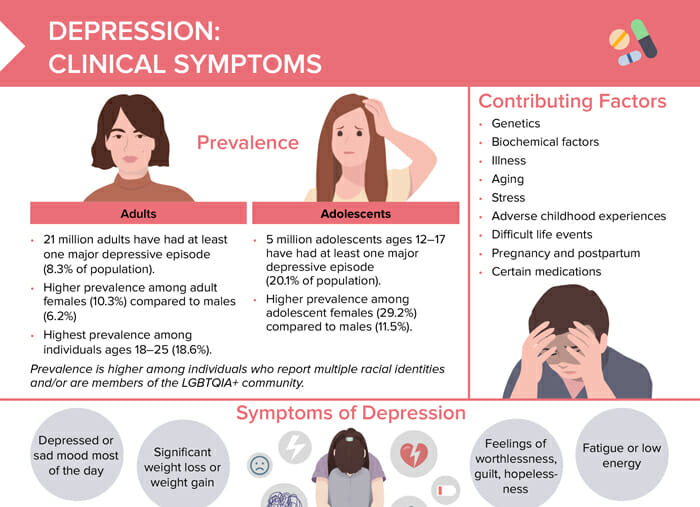What are the non-pharmacological treatment options for depression?
Aside from antidepressant medications, the following treatment measures are used for treating major depressive disorder:
- Psychotherapy
- Exercise
- Electroconvulsive therapy (ECT)
- Vagus nerve stimulation
How does therapy help in the treatment of depression?
In combination with pharmacological treatment, therapy is the first-line treatment for depression. It comes in many different forms that can be chosen according to the individual needs of a patient:
- Cognitive behavioral therapy: focused on identifying and changing negative thought patterns and behaviors
- Interpersonal psychotherapy: short-term, aims to improve interpersonal relationships and communication skills
- Family or couples therapy: addresses relationship dynamics to resolve conflicts and improve communication
- Supportive psychotherapy: therapeutic approach providing emotional support and validation
- Psychoeducational intervention: educating patients about their mental health conditions (often used in combination with other therapy models)
There is no evidence that one form of therapy is better than another. All forms help treat depression by equipping the patient with better coping skills, identifying negative thought patterns, and offering strategies to manage symptoms. This can lead to better mood regulation, improved relationships, and a higher quality of life.
Nursing note: Early discontinuation is common. Follow up with clients, just as you would when starting a medication.
How long does therapy take to work for depression?
The time it takes for therapy to work for depression can vary widely from person to person. Some may start to feel better within a few sessions, while others may need several months to notice significant improvement. Factors like the severity of the depression, the specific type of therapy, and how often therapy sessions occur can all influence the timeline. Generally, a commitment of at least 6 to 12 sessions is often recommended to assess its effectiveness.
Does exercise help with depression?
While exercise can help alleviate the symptoms of depression, it should only be used as an adjunct to other therapy measures. There are conflicting studies on its effectiveness.
As a recommendation, aerobic exercise or resistance training can be done 3–5x per week in 45–60 minute sessions, at 50%–80% maximum heart rate, for at least ten weeks.
Note: Exercise can improve other medical conditions beyond depression.
What is ECT therapy?
In ECT, electrical current is used to induce a generalized seizure under general anesthesia. ECT is considered safe and effective for treatment-resistant depression, but remains stigmatized due to perceptions of the procedure.
How does ECT work?
The mechanism of action is not fully understood. It is thought that ECT helps with depression by releasing neurotransmitters and changing brain connectivity.
How many ECT sessions are needed to feel better?
ECT typically requires multiple treatments to be effective. On average, 6–12 sessions are needed.
Continuation or maintenance ECT may be required. Generally, ECT is more effective when combined with pharmacotherapy.
When to stop ECT treatment
The decision to stop ECT is highly individualized and made by the psychiatrist in collaboration with the treated patient. Factors may include: significant improvement in depressive or psychotic symptoms, stabilization of mood, or the occurrence of intolerable side effects.
What is vagus nerve stimulation?
Vagus nerve stimulation is a surgical intervention under general anesthesia: An electrode is attached to the vagus nerve, which is connected to a pulse generator in the chest wall. Intermittent stimulation is produced by a hand-held transmitter.
Vagus nerve stimulation can be considered for treatment-resistant depression when at least 4 medications have failed.
Note: Serious adverse events can occur and evidence is still emerging as to the effectiveness of this treatment.
How does vagus nerve stimulation work?
The mechanism of action of vagus nerve stimulation in the treatment of depression is not understood.
What is treatment-resistant depression?
Depression is classified as treatment-resistant if the affected client does not respond adequately to standard treatments like medication and psychotherapy. Typically, a patient is considered to have treatment-resistant depression after failing to respond to at least two different antidepressant medications given at adequate doses for an adequate duration.

